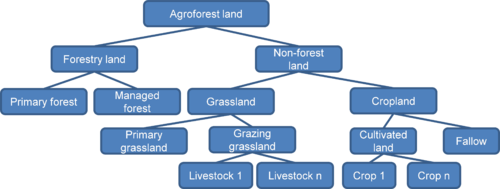Land-use - AIM-Hub
| Corresponding documentation | |
|---|---|
| Previous versions | |
| Model information | |
| Model link | |
| Institution | National Institute for Environmental Studies (NIES), Japan, https://www.nies.go.jp/index-e.html., Kyoto-University (Kyoto-University), Japan, https://www.kyoto-u.ac.jp/en. |
| Solution concept | General equilibrium (closed economy) |
| Solution method | Simulation |
| Anticipation | |
A function is used whereby land is an input for the production of crops and livestock products, and landowners change its use in accordance with the prices of goods produced on cropland, pastureland, and in forests. The model has a land nesting strategy, which is similar to the treatment in Sands and Edmonds (2005) and Wise and Calvin (2011). Land is categorized as one of nine ecological zones, and there is a land market for each zone. Allocation of land by sector is formulated as a multinominal logit function to reflect the differences in substitutability across land categories with land rent. Multinominal logit function allows us multi level nesting structure in logit selection. The function assumes that the landowner of each region and Agro-Ecological Zone (AEZ) decides on the land distribution among the possible options, with the land rent dependent on the production of each land type (i.e., crops, livestock, and wood products). We deal with all land excluding desert, rock, ice, tundra, and built-up land. The original social accounting matrix data has 18 AEZ classifications but the model deals with aggregated 9 classification.
The figure shows the nesting diagram for land using AEZ classification. We consider all land excluding desert, rock, ice, tundra, and built-up land. There are 18 AEZ classifications. At the top is all land, which is divided into two main nodes: forestry land and non-forest land. The forestry-land node contains two competing uses: primary forest (unmanaged forest) and secondary forest (managed forest). The non-forested land can be divided into grassland and cropland. The grassland can be further divided into primary grassland (unmanaged pasture) and grazing grassland (managed pasture that feeds marketed livestock); the latter is further divided into livestock types (1 to n). The cropland could be divided further into cropland for each crop type (1 to n) and fallow land. The nesting strategy is based on the assumption that the land regions are small enough that all competing options are equally substitutable. This assumption implies that it is as easy to switch from forest to wheat as it is to switch from corn to wheat. However, this conversion would not happen unless wheat was more profitable than forest or corn. The function assumes that the landowner of each region and AEZ subregion decides on the land distribution among the possible options depending on the land rent obtained from production with each land use (i.e., crops, livestock, and wood products). To calibrate the function for both the managed and unmanaged land in the base year, we took the mean base-year land rent of the managed land to be that of the unmanaged land because data for the unmanaged land were lacking. The carbon stock on forest land was evaluated by the price in the case of the climate mitigation scenario. The land rent of forest areas includes both the revenue from wood products and the price of the carbon stock.
